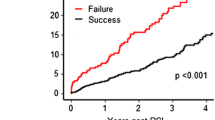Abstract
To investigate the long-term outcome of Percutaneous transluminal intervention (PCI) for chronic total occlusion (CTO). The subjects were 606 patients (1,145 lesions) who were treated for CTO between January 1996 and December 2003 at our institution. Among them, 436 patients with early success and confirmed patency at the CTO by follow-up coronary angiography after 6 months were classified as the patent group (Group P), while 170 patients without early success or with occlusion on follow-up angiography were classified as the occluded group (Group O). In April 2006 (mean: 660 ± 602 days), the outcome of CTO was investigated and the major adverse cardiac events (MACE)-free rate was calculated. Multivariate analysis was performed to identify determinants of death. The early success rate was 76.4% before 2003 when Conquest guidewires were not available. However, it subsequently showed significant improvement to 89%. The cumulative survival rate was significantly higher for Group P (92%) than for Group O (64%) and the MACE-free rate (free from, death, bypass surgery, myocardial infarction, and revascularization) showed a similar trend. The cumulative survival rate of patients without myocardial viability in the territory of the vessel with CTO was significantly higher for Group P (88%) than for Group O (55%). The outcome was significantly worse for patients with occlusion of other vessels (90%) than for patients without additional occlusion (42%). It was significantly better when the left ventricular ejection fraction (LVEF) was ≥40% than when the LVEF was ≤40% (90 vs. 68%). Multivariate analysis identified occluded CTO, other vessel occlusion, low ejection fraction (EF), unimproved EF, and old age as determinants of death from CTO. If early success is obtained and patency is maintained, the long-term outcome after PCI for CTO is significantly better than when failure occurs Occluded CTO, other vessel occlusion, low EF, unimproved EF, and old age are important determinants of the outcome.








Similar content being viewed by others
References
Saito S, Tanaka S, Hiroe Y, et al. Angioplasty for chronic total occlusion by using tapered-tip guidewires. Catheter Cardiovasc Interv. 2003;59:305–11.
Stone GW, Colombo A, Teirstein PS, et al. Percutaneous recanalization of chronically occluded coronary arteries: procedures techniques, devices, and results. Catheter Cardiovasc Interv. 2005;66:217–36.
Suttorp MJ, Laarman GJ, Rahel BM, et al. Primary stenting of totally occluded native coronary arteries II (PRISON II): a randomized comparison of bare metal stent implantation with sirolimus-eluting stent implantation for the treatment of total coronary occlusions. Circulation. 2006;114:921–8.
Ge L, Iakovou I, Cosgrave J, et al. Immediate and mid-term outcomes of sirolimus-eluting stent implantation for chronic total occlusions. Eur Heart J. 2005;26:1056–62.
Rentrop KP. Thrombolytic therapy patients with acute myocardial infarction. Circulation. 1985;71:627.
Tsukahara R. Myocardial viability in old myocardial infarction as evaluated by Tl-201 SPECT and two-dimensional echocardiography. Jpn Coll Cardiol. 1991;21:817–25.
Aziz S, Stables RH, Grayson AD, et al. Percutaneous coronary intervention for chronic total occlusions: improved survival for patients with successful revascularization compared to a failed procedure. Cathet Cardiovasc Diagn. 2007;70:15–20.
Suero JA, Marso SP, Jones PG, et al. Procedural outcomes and long-term survival among patients undergoing percutaneous coronary intervention of a chronic total occlusion in native coronary arteries: a 20-year experience. J Am Coll Cardiol. 2001;38:409–14.
Hoye A, van Domburg RT, Sonnenschein K, et al. Percutaneous coronary intervention for chronic total occlusions: the Thorax Center experience 1992–2002. Eur Heart J. 2005;26:2630–6.
Bakes T, van Geuns RJ, Dunkers DJ, et al. Prediction of left ventricular function after drug-eluting stent implantation for chronic total coronary occlusions. J Am Coll Cardiol. 2006;47:731–5.
Prasad A, Rihal CS, Lennon RJ, et al. Trends in outcomes after percutaneous coronary intervention for chronic total occlusion. A 25-years experience from the Mayo clinic. J Am Coll Cardiol. 2007;49:1611–8.
Mitsudo K, Yamashita T, Asakura Y, et al. Recanalization strategy for chronic total occlusion with tapered and stiff-tip guidewire. The results of CTO new technique for standard procedure (CONQUEST) trial. J Invasive Cardiol. 2008;20:571–7.
Sianos G, Barlis P, Mario CD, et al. European experience with the retrograde approach for the recanalization of coronary artery chronic total occlusions. A report on behalf of the Euro CTO Club. Eurointervention. 2008;4:84–92.
Buller CE, Dzavik V, Carere RG, et al. Primary stenting versus balloon angioplasty in occluded coronary arteries: the total occlusion study Canada (TOSCA). Circulation. 1999;100:236–42.
Srines PA, Golf S, Myreng Y, et al. Stenting in chronic total occlusion (SICCO): a randomized controlled trial of adding stent implantation after successful angioplasty. J Am Coll Cardiol. 1996;28:1444–51.
Werner GS, Krack A, Schwarz G, et al. Prevention of lesion recurrence in chronic total coronary occlusions by paclitaxel-eluting stents. J Am Coll Cardiol. 2004;44:2301–6.
MIgliorini A, Moschi G, Vergara R, et al. Drug-eluting stent-supported percutaneous coronary intervention for chronic total coronary occlusion. Cathet Cardiovasc Diagn. 2006;67:344–8.
Felice FD, Fiorilli R, Parma A, et al. Clinical outcome of patients with chronic total occlusion treated with drug-eluting stents. Int J Cardiol. 2009;132:337–41.
Valenti R, Migliorini A, Signorini U, et al. Impact of complete revascularization with percutaneous coronary intervention on survival in patients with at least one chronic total occlusion. Eur Heart J. 2008;29:2336–42.
Garcia HM, Daemnen J, Kukreja N, et al. Three-year clinical outcomes after coronary stenting of chronic total occlusion using sirolimus-eluting stents: insights from the rapamycin-eluting stent evaluated at Rotterdam cardiology hospital (RESEARCH) registry. Catheter Cardiovasc Interv. 2007;70:635–9.
Author information
Authors and Affiliations
Corresponding author
Rights and permissions
About this article
Cite this article
Muramatsu, T., Hirano, K., Tsukahara, R. et al. Long-term outcome of percutaneous transluminal coronary intervention for chronic total occlusion in the BMS era in Japan. Cardiovasc Interv and Ther 25, 78–84 (2010). https://doi.org/10.1007/s12928-010-0016-1
Received:
Accepted:
Published:
Issue Date:
DOI: https://doi.org/10.1007/s12928-010-0016-1




